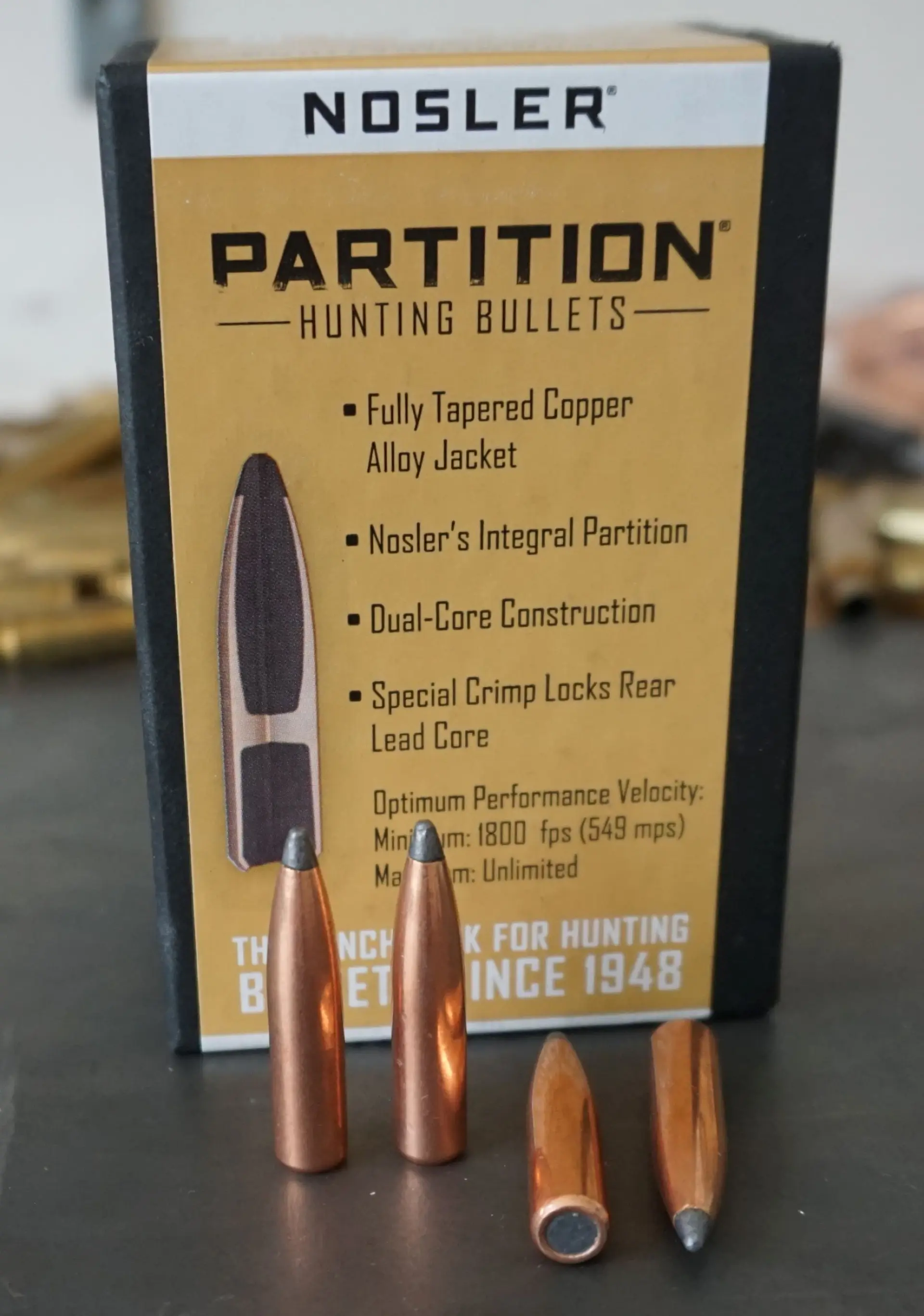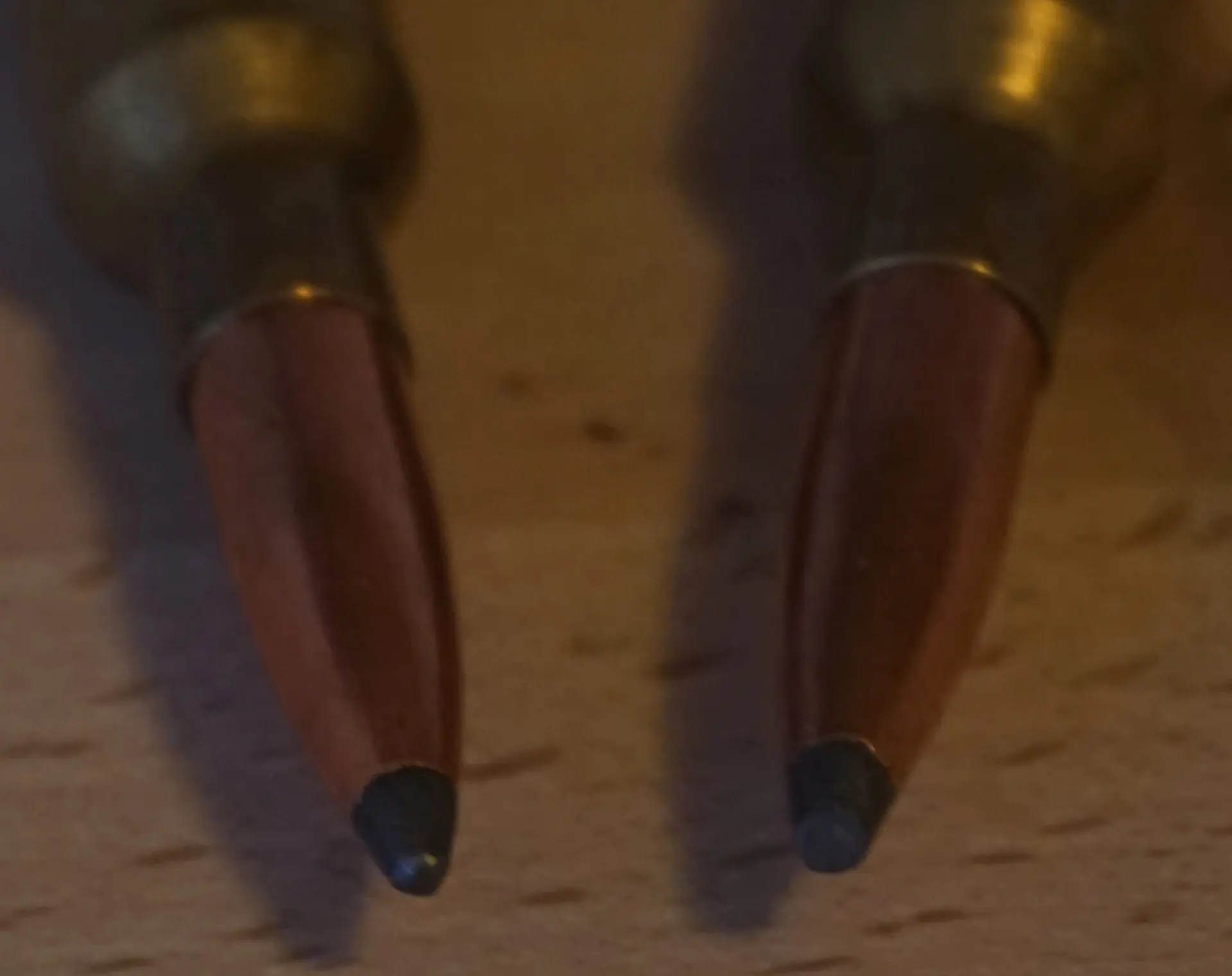Tip with two cores

The Partition bullet belongs to the "family silver" of American ammunition manufacturer Nosler, which has been producing it since its founding in 1948. But how does it fare against today's fierce competition? We've tested it for you.
Introductory photo: Nosler Partition bullet in 6.5 Creedmoor cartridge.
The Nosler Partition bullet is highly popular among hunters, and it's no surprise. It has been proven over decades of real-world practice, which earned it a reputation for reliable terminal performance on a wide range of game across all common and longer ranges, while also offering exceptional accuracy. And I can already reveal that my experience confirms this reputation.
But let's proceed step by step – starting first with the technical aspects. The design of Partition bullets is quite complex, containing two lead cores. On a cross-section, the jacket forms an H-shape, into which the first core is inserted at the top, which is shaped into the bullet tip. Thus, it is a semi-jacketed bullet with a spitzer shape. In the lower section, we find the second core, protected by a thick jacket on three sides (the bottom is partially open), while the jacket thins towards the tip. The concept behind the design is that the front part of the bullet is meant to deform easily, while the rear core and jacket stay tightly bonded together and make up about two-thirds of the bullet's weight. This means that even at extreme impact velocities and with massive destruction of the front section, the rear part remains intact with enough residual weight to penetrate tissue deeply enough.

Cross-section of the bullet reveals its unusual double-core construction. This ensures high weight retention after impact on the game, combined with willing expansion of the front part.
"The manufacturer offers the bullet in a total of 35 variants and calibers, from .224 to .375. The Central European classics 7 mm, 8 mm and 9.3 mm are also included!"

Nosler Partition bullets in .264 caliber and 140 grains with their box in the background. At first glance, it may look like a classic soft point, but the bullet is deceptive in appearance.
Wide Selection
If we set aside factory ammunition, which is covered in a separate box, the manufacturer offers the Partition bullet in a total of 35 variants and calibers, ranging from .224 to .375. Included are the Central European classics 7 mm, 8 mm, and 9.3 mm. The offering thus covers most of today's commonly used calibers. I tested the .264 caliber, 140-grain variant in 6.5 Creedmoor ammunition with a Ruger American Predator bolt-action rifle with a 559 mm (22”) barrel. As usual, I tried several different powder charges and seating depths, and I can say that, at least in this cartridge and rifle, it is quite a tolerant bullet that performed more than satisfactorily with each tested combination. The best results were achieved with a charge of 44 grains of Swiss 60 powder and an overall cartridge length of 71 mm. The measured average velocity was 879 m/s, with an energy of 3,324 J. Partition bullets are very well-made at first and second glance, and the weight deviation between randomly selected bullets from the box was negligible. It's worth noting that the Partition series has slightly above-average ballistic coefficients. In my case, it was a respectable 0.490.
The accuracy is excellent. Honestly, I was a bit worried about the long, exposed lead tip, which is sturdy enough to survive reloading without deformation but does deform slightly in the magazine during shooting due to recoil, specifically the tip hitting the front wall of the magazine. Of course, this depends on the power of the cartridges. With .223 Rem, this likely won’t happen, whereas with .300 Rem Mag, it’s a different story. After all, this is not a perfectly shaped polymer tip. I can say that the tested bullets in 6.5 Creedmoor, after firing half a magazine, showed slight but undeniable signs of deformation. And this was with a polymer magazine, where impact against the walls is probably less traumatic for the bullet than in metal magazines. However, the groupings quickly reassured me. I compared the performance between individual rounds and full sets loaded into the magazine, and I found no measurable difference in grouping or point of impact. This aligns with the experiences of other shooters using Partition bullets, even in much more powerful cartridges, including the aforementioned .300 Rem Mag.
Almost Unmatched in Accuracy
So, what do the numbers say about accuracy? At a distance of 100 meters (measured from the center of the groups, averaged from three series of six shots, with the worst shot in each series excluded), I managed to achieve a group size of 13 mm, which is just under 0.5 MOA! It wouldn't surprise me if the potential of these bullets is even better. At this point, the results reflect the maximum potential of the setup – the rifle, scope, mounts, and shooter. Such numbers can be compared with top-tier match-grade bullets, which are specifically designed for precision shooting. Among hunting bullets, perhaps only the Hasler monolithic bullets could compare, at least in my rifle, based on what I’ve had the opportunity to test so far (and that’s quite a bit). For a semi-jacketed bullet with an exposed core, these are surprisingly good results. Reports from other users of Partition bullets in different calibers confirm excellent accuracy, reliably under 1 MOA (groups under 26 mm at 91 meters), and they also affirm that the bullet is relatively tolerant. By this, I mean that it works satisfactorily with most rifles.

Results from the shooting range with a 100-meter group speak for themselves (the sticker shows 1 MOA, which is 26 mm edge-to-edge).
"At 100 meters, I managed to achieve a group size of 13 mm with the Partition, which is just under 0.5 MOA!"

Detail of the tip deformation from the bottom of the magazine after firing nine rounds (right) compared to an intact tip (left).
A True All-Rounder
So, we've covered accuracy, but how does the Partition bullet perform in actual hunting? Excellently! The dual-core design really works. In the recovered bullets I managed to find, the retained weight consistently stayed above 75%. The bullet performs well at both short ranges, with higher impact velocities, and on distant game. Partition is, to a large extent, a versatile bullet. It reliably expands even on light game like roe deer (which I personally verified). According to the manufacturer, a relatively low impact velocity of 545 m/s is sufficient for this. Wild boars also drop quickly, either right on the spot or within short distances from where they were shot. Deformation doesn’t require “help” by placing shots on the shoulder, as is the case with monolithic bullets. I didn’t notice any decrease in terminal performance when shooting through ribs. The damage to the meat was typical for high-quality semi-jacketed bullets with a core bonded to the jacket. Nothing too severe, but of course, it also depends on the impact velocity. At 20 meters with a fast cartridge, the meat will likely show some damage.
The primary target for Partition bullets is heavier, trophy game. After all, they are relatively expensive, which we’ll get to shortly. For budget-conscious hunters, especially those who need to cull a large number of light-skinned or smaller boar at close range, Partition might not be the best choice. There are more cost-effective and sufficient alternatives available for such scenarios. However, for large boars, trophy game, and long-range shooting, it is ideal. In a properly powerful cartridge, it will certainly be sufficient for paid hunts abroad, including those after heavy and/or dangerous African and North American game. In the U.S., it is a popular choice for hunting bears and elk (wapiti), which can weigh over 400 kilograms and are known for being tough to bring down.
You Pay for Quality
As I’ve already hinted, Partition bullets are definitely among the more expensive options on the market. The variant I tested, in .264/140 grain, costs 40.4 CZK per bullet. Depending on caliber and weight, the price ranges from 28.7 to 68.9 CZK, with boxes typically sold in packs of 50. In practice, there’s really nothing to criticize about this bullet. It functions reliably, is very accurate, highly versatile, and offers excellent ballistics. Among hunting bullets with lead cores, it ranks at the top, outpacing all classic soft points and, as long as the tip doesn’t completely deform, even surpasses "modern" bullets with ballistic tips. On the other hand, in this price range, it does face competition from modern monolithic bullets. However, these tend to have the drawback of being made from tougher materials, meaning they often need to hit bone to achieve proper expansion. This is not usually an issue in practice, but Partition still scores points for its design, which ensures it opens “just right” under most conditions.

Nosler Partition bullets in .264 caliber and 140 grains with their box in the background. At first glance, it may look like a classic soft point, but the bullet is deceptive in appearance.
“Factory” from Several Ammunition Manufacturers
Nosler doesn’t just offer bullets, but also caters to those who do not reload their ammunition. For them, there is the Nosler Trophy Grade line of factory-loaded ammunition, available in no less than 34 variants, all of top-notch quality. Unfortunately, Factory-loaded Partition ammo isn’t very common on our market. Specifically, the Trophy Grade line can be found, but it is usually the version loaded with Accubond bullets.
However, there’s no need to despair, as the Partition bullet is not only used in Nosler's “parent” ammunition but also by several other manufacturers. This alone says something about the quality of the bullets. Specifically, Winchester, Federal, and (at least until recently) the local manufacturer Sellier & Bellot have used Partition bullets in their loads. So, it’s not hard to find “factory-loaded” ammo even on our market. For example, the Federal Vital Shok .30-06 round loaded with the sought-after bullet costs 69 CZK per round (proarms.cz). Additionally, these factory-loaded rounds are available in calibers you won’t find in the list of bullet-only options. Specifically, we’re talking about .416 and .450 in the form of .450 Rigby, .416 Rem Mag, 500/416 NE, and the popular .416 Rigby.
You can purchase Nosler Partition bullets at Strobl s.r.o. For more information, visit strobl.cz or the manufacturer’s website, nosler.com.
Advantages/Disadvantages
+ Excellent accuracy and ballistics
+ Reliable terminal performance
+ Versatile for most game and shooting distances
+ Availability of factory-loaded ammunition and bullets on our market
- High price
- More delicate tip (but no impact on accuracy)
Photo Sources: Author's archive, materials from the manufacturer: nosler.com
Author: Tomáš Prachař
The article originally appeared in the magazine *Lovec* by Extra Publishing.








